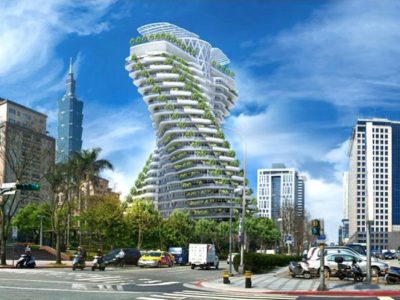 High-rise farming is the latest trend in the urban gardening movement.
High-rise farming is the latest trend in the urban gardening movement.
If the new practice proves successful, city dwellers could soon be strolling along a sixth floor orchard to pick fresh apples for an evening snack from their very own “farmscraper.”
The “food in the sky” may conjure up images of balcony planters and wall-mounted growing baskets, but it should not. The futuristic high-rise farm involves the development of rice paddies housed inside glass enclosures that both heat and cool themselves. The new style of urban gardening includes a setup where rainwater is captured and residential wastewater is recirculated for the plants.
Belgian architect Vincent Callebaut, according to AFP news, designed the 132-floor urban farm plan. He feels such a metropolitan gardening and living arrangement will lead to a “healthier, happier future” for the estimated six billion people who will live in urban areas by 2050.
The 36-year-old designer believes that the future of cities will be extremely gloomy due to the decrease of water, food and energy sources. Callebaut is advocating for a “living organism” or self-sufficient style of metropolitan living. Some have dismissed his designs as either crazy or a “blight on the landscape,” according to AFP.
Said Callebaut:
We need to invent new ways of living in the future. The city of tomorrow will be dense, green, and connected. The goal is to bring agriculture and nature back into the urban core so that by 2050 we have green, sustainable cities where humans live in balance with their environment. … They [critics] made fun of me. They said I created a piece of science fiction.
The sustainable city living movement has reportedly grown urgent due to the encroachment upon valuable rural farmland fostered by urban sprawl. Callebaut and his supporters also believe that the loss of land had led to increased pollution and caused “earth warming” carbon emissions.
Without A Doubt The Best Kept Secret In Self-Reliance Gardening…
The designer has entitled his urban gardening project “Dragonfly.” The plans for an enormous “vertical farm” features twin towers and includes placing the first structure on New York’s Roosevelt Island. Each one of the towers will include a steel and glass wing edifice which will resemble a dragonfly’s wing. The structure also includes space for dairy, egg and meat production, public recreation areas, meadows, orchards and offices or apartments.
Energy for the Dragonfly complex will be garnered from both the wind and the sun. Hot air trapped under the “wings” will reportedly provide cool air in the summer and heat in the winter via a natural ventilation process and an abundance of plant growth. Plants growing on the exterior of the building shell will filter rain water which is then mixed with liquid waste and treated to become organic fertilizer. A floating market along the East River will offer the Dragonfly residents a venue to sell their organic crops.
Callebaut debuted his design at an international fair in China. Although the exposure vastly increased interest in the project, no buyers have yet stepped forward. The designer has also come up with an idea for a floating city that will resemble the shape of a lily pad and serve as housing for “refugees forced from their homes by climate change.” Callebaut hopes that Shenzhen, China, will buy one and build one of his farmscrapers to help combat their overpopulation and pollution problems.
Emilia Plotka, sustainability expert for the Royal Institute of Royal Architects, told AFP:
With the recent economic recession, politicians and government may have been reluctant to venture into such new, large-scale endeavors that have not been tested before. Instead of majestically tall bionic towers plonked in riverbeds, vertical farms have been rather more modestly integrated into existing buildings, derelict industrial sites and floating barges. Whilst the buy-in may not be as noticeable at the moment, it certainly is widespread and growing.
Although people who support urban farming would also back any sustainable food, water, and energy ideas which can enhance health and reduce reliance on the food supply chain, some consider Callebaut-style projects an indication that the Agenda 21 movement may be growing in America.
Sign up for Off The Grid News’ weekly email and stay informed about the issues important to you
 Off The Grid News Better Ideas For Off The Grid Living
Off The Grid News Better Ideas For Off The Grid Living




